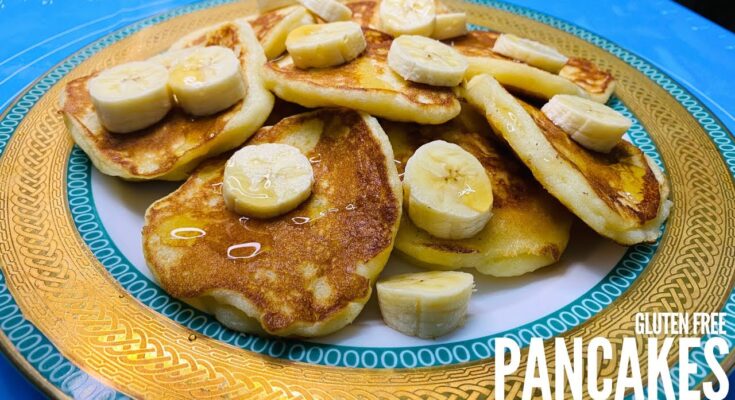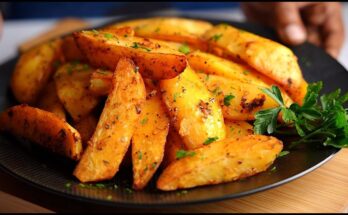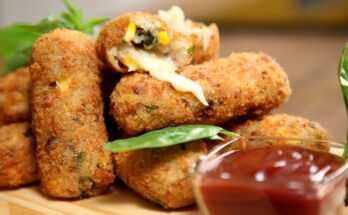Gluten Free Pancake Recipe: Who doesn’t love a stack of fluffy, delicious pancakes? But if you’re someone who needs to or chooses to avoid gluten, traditional pancakes might be off the menu. That’s where gluten-free pancakes come in. These delightful, easy-to-make pancakes allow you to enjoy your favorite breakfast without the gluten. Whether you have celiac disease, a gluten sensitivity, or just want to experiment, this guide is perfect for you.
Not only are gluten-free pancakes simple to prepare, but they also offer a variety of health benefits. Gluten-free diets are often linked to improved digestion, reduced inflammation, and increased energy levels. Ready to whip up some magic? Let’s dive into the step-by-step guide.
Ingredients Needed for Gluten-Free Pancakes
Dry Ingredients
To start, gather these essentials:
- Gluten-Free Flour Blend: Choose a mix with xanthan gum for better texture.
- Baking Powder: Helps make the pancakes rise and stay fluffy.
- Salt: Just a pinch to enhance flavors.
- Sugar: Optional, for a touch of sweetness.
Wet Ingredients
- Milk or Plant-Based Milk: Almond, oat, or soy milk work perfectly.
- Eggs or Substitutes: Use flax eggs or applesauce if you’re vegan.
- Vanilla Extract: Adds depth to the flavor.
Feel free to adjust these ingredients based on your dietary needs or preferences.
Tools Required for Making Pancakes
Here’s what you’ll need to make the magic happen:
- Essential Tools: Mixing bowls, whisk, non-stick frying pan, ladle, and spatula.
- Optional Tools: Electric griddle for larger batches or a pancake dispenser for uniform sizes.
Having the right tools ensures a smooth cooking process and perfectly cooked pancakes.
Preparing the Batter
Step 1: Mix Dry Ingredients
Combine the gluten-free flour, baking powder, salt, and sugar in a large bowl. Sift them together to avoid lumps and ensure an even texture.
Step 2: Incorporate Wet Ingredients
In another bowl, whisk together the milk, eggs, and vanilla extract. Slowly pour this mixture into the dry ingredients.
Step 3: Achieve the Perfect Consistency
Stir gently until the batter is smooth. Avoid overmixing—it can make the pancakes dense. The batter should be thick but pourable.
Cooking Gluten-Free Pancakes
Preheating and Greasing the Pan
Heat a non-stick pan or griddle over medium heat. Lightly grease with butter or oil to prevent sticking.
Cooking and Flipping Techniques
Pour about 1/4 cup of batter onto the pan. Cook until bubbles form on the surface and the edges look set (around 2-3 minutes). Flip and cook for another minute or two until golden brown.
Common Mistakes to Avoid
- Don’t use high heat—it burns the pancakes outside while leaving the inside undercooked.
- Avoid flipping too soon; wait for the edges to firm up.
Tips for Fluffy Gluten-Free Pancakes
Want your pancakes to be cloud-like? Follow these tips:
- Use the Right Flour Blend: A mix with xanthan gum ensures elasticity.
- Leavening Agents: Extra baking powder or a dash of baking soda helps create air pockets.
- Rest the Batter: Let the batter sit for 10-15 minutes before cooking. This hydrates the flour and improves texture.
Serving Suggestions
Classic Toppings for Pancakes
- Maple syrup and butter are timeless favorites.
- A sprinkle of powdered sugar adds a touch of elegance.
- Fresh fruits like strawberries, blueberries, or banana slices bring natural sweetness and a refreshing contrast.
Creative Topping Ideas for a Twist
- Nut Butters: Peanut butter, almond butter, or sunflower seed butter for added protein.
- Chocolate Lovers: Drizzle melted dark chocolate or add chocolate chips to the batter.
- Savory Options: Try cream cheese with smoked salmon or avocado slices for a savory take.
Pairing Pancakes with Sides
- Serve alongside scrambled eggs and crispy bacon for a hearty breakfast.
- Add a green smoothie or freshly brewed coffee for a balanced start to the day.
Storing and Reheating Pancakes
Best Practices for Storing Leftovers
To keep pancakes fresh:
- Let them cool completely before storing.
- Place them in an airtight container or resealable bag.
- Refrigerate for up to 3 days or freeze for up to 2 months.
Tips for Reheating Without Compromising Texture
- Microwave: Heat pancakes in 10-15 second intervals to avoid overcooking.
- Oven: Warm them at 300°F for about 5 minutes for a fresh-from-the-pan taste.
- Toaster: This method adds a slight crispness to the edges.
Gluten-Free Variations
Vegan Gluten-Free Pancakes
Replace eggs with flaxseed or chia seed gel (1 tablespoon seeds + 3 tablespoons water per egg). Use plant-based milk and coconut oil for a vegan-friendly twist.
Dairy-Free Options
Substitute dairy milk with almond, coconut, or oat milk. Use oil or vegan butter instead of regular butter.
Sugar-Free Pancake Ideas
Omit sugar entirely or use natural sweeteners like honey, maple syrup, or mashed bananas for a healthier alternative.
Troubleshooting Gluten-Free Pancakes
Common Issues and Solutions
- Pancakes Fall Apart: Add a teaspoon of xanthan gum or psyllium husk for better binding.
- Dense Texture: Increase the baking powder slightly or fold in whipped egg whites.
- Sticky Batter: Reduce liquid or add a bit more flour to achieve the right consistency.
Adjustments for Altitude and Humidity
- At high altitudes, reduce baking powder slightly and increase the liquid.
- In humid conditions, reduce liquid and store flour in a cool, dry place.
Health Benefits of Gluten-Free Pancakes
Gluten-free pancakes aren’t just for those with gluten intolerance—they can be a healthier choice for anyone. Here’s why:
- Improved Digestion: Many people find gluten-free recipes easier on the stomach.
- Lower Inflammation: Avoiding gluten can reduce inflammation, especially for those with sensitivities.
- Nutritional Value: Gluten-free flours like almond or oat flour are rich in vitamins, minerals, and fiber.
FAQs about Gluten-Free Pancake Recipe
What makes pancakes gluten-free?
Gluten-free pancakes substitute gluten-containing flours, such as wheat, with alternative flours like almond, coconut, or rice flour. This allows individuals with gluten sensitivities or celiac disease to enjoy pancakes without adverse health effects.
Can I use regular pancake mix to make gluten-free pancakes?
No, regular pancake mixes typically contain wheat flour, which has gluten. To make gluten-free pancakes, you must use a gluten-free pancake mix or a blend of gluten-free flours specifically designed to be free of gluten.
Are gluten-free pancakes as fluffy as regular pancakes?
Yes, gluten-free pancakes can be just as fluffy as their gluten-containing counterparts. The key is in the leavening agents used, such as baking powder or baking soda, which help the pancakes rise. Additionally, ingredients like eggs and buttermilk can aid in achieving a fluffy texture.
What are some common gluten-free flours used in pancake recipes?
Common gluten-free flours include almond flour, coconut flour, rice flour, and buckwheat flour. Each flour offers a unique flavor and nutritional profile, allowing for customization based on dietary needs and taste preferences.
Can I add flavors or toppings to gluten-free pancakes?
Absolutely! Gluten-free pancakes are versatile and can be enhanced with various add-ins and toppings. Popular choices include fresh fruits, nuts, chocolate chips, and spices such as cinnamon or vanilla extract.
How do I prevent gluten-free pancakes from being gritty?
To avoid a gritty texture, finely ground gluten-free flours are recommended. Additionally, ensure thorough mixing of ingredients to distribute the flour evenly. Some recipes also benefit from letting the batter rest for a few minutes before cooking, allowing the flour to hydrate and soften.
Where can I find gluten-free pancake recipes?
Gluten-free pancake recipes are widely available online, in cookbooks dedicated to gluten-free cooking, and on food blogs that specialize in gluten-free diets. These resources often provide tips and variations to help you customize the recipes to your liking.
Conclusion
Gluten-free pancakes are a delicious and versatile way to enjoy a comforting breakfast without compromising your dietary needs. With this step-by-step guide, you can master the art of creating fluffy, flavorful pancakes that everyone will love. Experiment with different variations, toppings, and techniques to find your perfect combination. Whether you’re serving a crowd or enjoying a quiet breakfast at home, this recipe is sure to impress.



